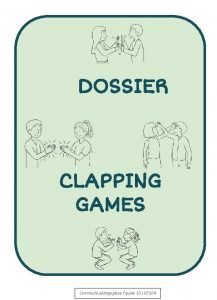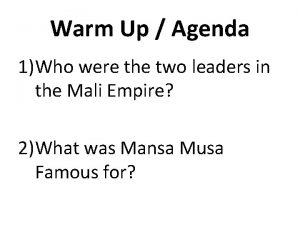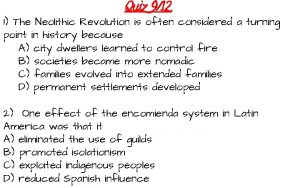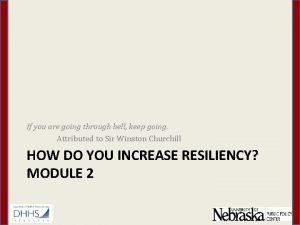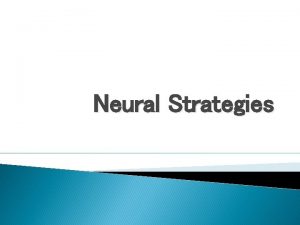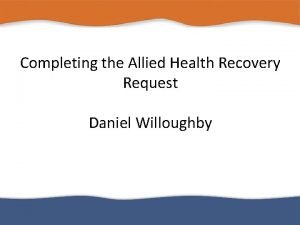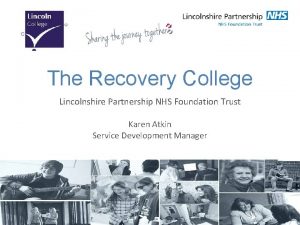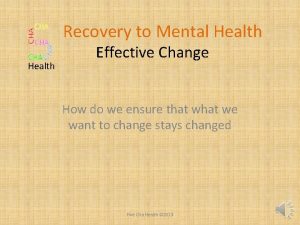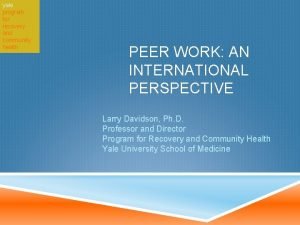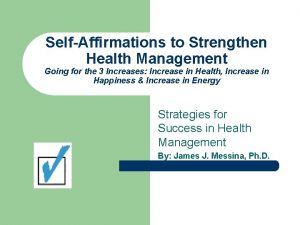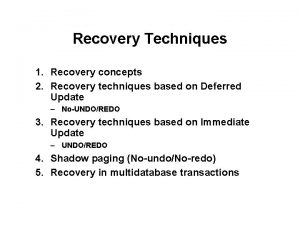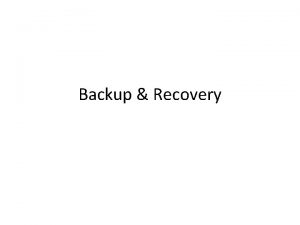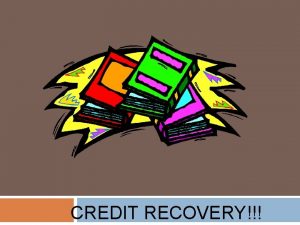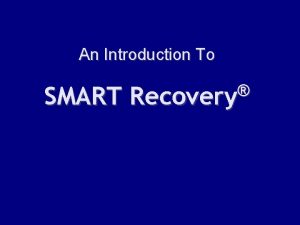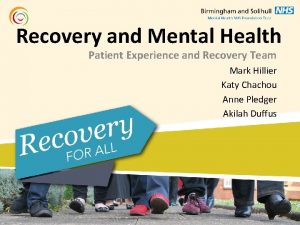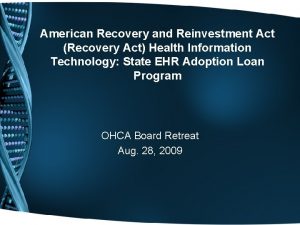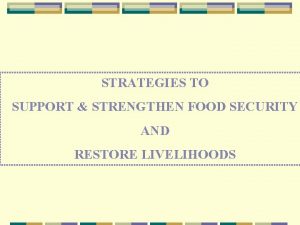Recovery Strategies to Strengthen Health Management Going for

























- Slides: 25

Recovery Strategies to Strengthen Health Management Going for the 3 Increases: Increase in Health, Increase in Happiness & Increase in Energy Strategies for Success in Health Management By: James J. Messina, Ph. D.

Common Thoughts Associated with Effort to Change Unhealthy Living l l l Testing control: “I can go to parties and events (see friends and colleagues who are alcohol users, overeaters, drinkers, or pot or cigarette smokers) without using. ” Life will never be the same: “I love being high from doing unhealthy habits which I love to do!” Failure: “Previous treatments and efforts to change my habits haven’t worked; there’s no hope for me. ” 2

Common Thoughts Associated with Unhealthy Habits l l l Diminished pleasure: “The world is boring without …(My bad habit of choice: eating, no exercise, poor sleep, smoking, drinking alcohol or using drugs etc. )” Entitlement: “I deserve a reward so I am going to continue the habits which others say are wrong. ” Feeling uncomfortable: “I don’t know how to be with people if I’m not doing the unhealthy things I do. ” What’s the use of trying: “I screwed up again, I might as well continue to doing those unhealthy things. ” Escape: “My life is so bad, I just need a break for a few hours. ” 3

How to counter thoughts which lead to your unhealthy habits l l l Think of unpleasant aftermath of results you get when you do your unhealthy habits Challenge thoughts with an alternative thought -use humor & reframing Review negative consequences to counter the urgings & cravings to use unhealthy habits Use distracting pleasant activities to prevent your going back to your unhealthy habits What follows are 3 Techniques: Journal Writing, 4 Behavioral Chains and Thought Stopping

How to counter thoughts which lead to your unhealthy habits l l Seek out supportive friends or support grout who are understanding so as to pinpoint steps you need to take to not relapse to poor habits Keep a journal of your thoughts, feelings & reactions to people, places, situations & conditions so that you can identify if you are building up to going back to your old pattern of unhealthy habitual living 5

Journal writing helps you plan your recovery from unhealthy habits Changes I will make while focused on recovery: Reasons why I want to make these changes: Steps I plan to take to make these changes: Ways other people can help me make changes: Things which might interfere with my change plan: 6

In Journal keep track of thoughts about unhealthy habits Thoughts about unhealthy habits I have: 1 2 3 7 Positive thoughts & coping skills used to counter these thoughts:

In Journal write about people who involved in your unhealthy habits Person(s) who gets me to ignore healthy ways of living when we are together 1 2 3 8 Honest statement how good this person is for me to hang out with in my recovery

Write about Healthy Habit Alternative Activities to do Old Activities I did which led to my unhealthy habits: 1 2 3 9 New Activities I will do which will prevent my old unhealthy ways:

Use Behavioral Chains in Recovery from Unhealthy Life-Style Behavioral Chains are: l Series of specific behaviors resulting in a final behavior in need of attention, remediation, or change before a recovered lifestyle can be achieved or regained l Steps leading to a behavior targeted for change or relapse prevention work. l Series of stimuli/response reactions, ultimately leading to a problem behavior or relapse event. l Specific behavior traits that make up & are the causal agents of a problem behavior pattern when linked together. l Linked behavior traits with some degree of predictability as to the ultimate consequence or outcome. l The result of linking emotional cues & respondent behaviors into a series of events that contribute to the exacerbation of problem behavior patterns or relapse of this pattern

Characteristics of Behavior Chains l l l l If the chain of behavior patterns is broken at any point, it probably will not progress to the final behavior. The earlier the break in the link, the easier it is to undo the chain. Behavior chains often go unidentified prior to the occurrence of the final link in the chain. Behavior chains are self‑propelling; they have a momentum of their own to go on and on. The chains can be diagramed, but one must begin with the last link and trace backward to each preceding behavior or emotional cue. Behavior chains can be broken into habitual patterns that give insight into chain‑breaking strategies & alternative behavior traits which help to prevent future relapse. Have a look at a Behavior Chain for Beer Relapse:

The Beer Relapse Part 1: l l l l You have had a horrible day at work and are feeling pressured by your boss to either increase daily quota of work or face poor performance evaluation. You leave work in distress, upset over not having been assertive, not standing up for your rights with the boss. In the heavy commuter traffic, you feel upset over course of the day. Driver in the car next to you cuts in front of you, making you shout and gesture to him. You pass several bars and think of a big, cool beer. You honk horn loudly at driver in front of you who has slowed down the pace of traffic. Angry at self for losing temper. See billboard with a local watering hole advertised.

The Beer Relapse Part 2: l l l You feel the seat belt pressing in on your stomach and you think more about your thirst and desire for a beer to quench that thirst. Depressed over your boss's inability to show appreciation for your good work. Annoyed at the slow pace of traffic. Getting angry and tasting the beer as you pass the twelfth bar. Finally you pull into a bar parking lot. You call home to say you will be late, that you have more work to do at the office. Check your wallet to see if you have enough money for a beers. Angry at self for allowing work, boss, and traffic to upset you. Get into bar and stand at the bar counter. Feel exhilarated when it is your turn to order. Order a large, cool tap beer.

The Beer Relapse Part 3: l l l l l Mentally review the day's events as you wait for your beer to come. Get angry again over your boss's rudeness and lack of caring. Feel depressed as you review the route your life has taken: overworked, underappreciated, and taxed by a forty‑five minute commute twice a day. Feeling sorry for self for the hard knocks life has dealt you. Your bottle of beer arrives and you feel excited over your rewarding of yourself; you deserve it! Pay for beer and become intoxicated by the aroma. You drink your first slug of beer. You take a deep breath, feeling rewarded and at peace. You continue to drink slug after slug of your beer and relish each flavor. You force yourself to order another beer.

The Beer Relapse Part 4 l l You feel after the second beer is guzzled down, embarrassed: What have you done! Why did you drink two beers? Guilty and depressed since you have been in treatment for alcohol use disorder, you dispose of all evidence that you were at the bar. You drive home feeling hopeless, trapped. Why did you lie about doing work at the office when you were going for two beers? Why did you drink? Why did you threaten your recovery. You hate yourself. You know you need to bring this up to your AA Sponsor and maybe even talk about this relapse event in your AA meeting tomorrow night.

How can people control a behavioral chain? In order to control a behavioral chain, the links need to be identified and broken. people can work at: l l l Interpreting events in one’s life differently so that they are less likely to have the power to lead the people to exercise habitual problem behavior or relapse to old behaviors. Using rational thinking about what is happening in one’s life eliminates the "shoulds'' and "musts'' from people’ thinking about how others should treat them and how they should treat others. Substituting positive affirmations and positive self‑talk when people are being bombarded with emotional cues or irrational thoughts about themselves, events, or others. Taking responsibility for their own actions, not blaming other persons or events for making them fall into the behavior chain. Substituting alternative, healthy behavior, for those behavior traits that lead to the problem behavior or relapse event.

How can people control a behavioral chain? Part 2 In order to control a behavioral chain, the links need to be identified and broken. people can work at: l l l Substituting required activities for antecedent behavior in a chain, such as doing office work, paying bills, cleaning the house, opening the mail, paying attention to defensive driving techniques, etc. Substituting enjoyable activities for antecedent behaviors in a chain such as enjoying a hobby, listening to music, exercising, calling a Support Group, AA or NA Buddy, writing a letter, going to a movie, reading for pleasure. Substituting positive behavior in a chain of behavior known to lead to habitual problems or relapse events. Reinforcing positive behavior traits and ignoring negative behavior patterns, or substituting new behavior traits for negative behavior patterns or relapse events. Recognizing the behavior that habitually leads to predictable, negative‑consequence behavior chains or relapse events.

What beliefs block people from recognizing the behavioral chains in their problem behavior patterns? l l l l l I never know why I do the things I do. It's beyond me. There is no sense in looking at the causes of my behavior. What's important is to treat the symptoms. I've always done it this way. I will never change. What difference does it make what behavior preceded my problem behavior? All I know is I have a problem I can't seem to shake. It takes too much time to work on analyzing the chain of events leading to my problem behavior. So, what difference will it make to identify antecedent behaviors or events when they are out of my control anyway? I'm compulsive; that's all I need to know to explain why I act the way I do. I'm so embarrassed by the way I act; I'd hate to tell anybody else about it. I am a loser and there is no helping me. If it weren't for ____ (spouse, parent, child, boss, job, problem of the day), these things would never happen.

Use Thought Stopping in Recovery What is thought stopping? It is the: l l l l l Process by which people are able to cease dwelling on a thought bothersome to them Procedure used to stop thoughts that are cues to acting impulsively or compulsively Process by which people are able to break the power of the cues that lead you into addictive binge‑like or relapse behaviors Substitution of a healthy thought for an unhealthy thought Act of deliberately turning to cues that break unhealthy patterns or habits. Ability to discontinue obsessing on an idea, image, thought, fear or stimuli that is a cue for unhealthy behavior Practice of using mental energy in a positive way Technique used to reduce the negative impact of stress, unhealthy emotional cues, and fears Stress‑reduction technique that eliminates the overwhelming impact of 19 stress and/or crisis events

How does thought stopping work? In thought stopping people: l Replace one thought for another, i. e. , the thought of drinking is replaced by the thought of exercising l Hear “stop'' literally or figuratively whenever a negative or unhealthy thought arises, e. g. , the desire for a beer appears and “stop'' is immediately heard l Are able to break an obsessive, unhealthy thought pattern by substituting a healthy thought pattern l Are able to replace a negative or unhealthy image with a positive visual image l Can divert or detour their minds from unhealthy or negative thoughts l Can clear minds of all unnecessary and unhealthy thoughts that create stress or cues for acting out in unhealthy ways 20

What are some Thought‑Stopping techniques? Thought Replacement: when an unwanted thought enters, immediately replace thought with a healthy, rational one Yelling “Stop”: on thinking the unwanted thought, immediately yell STOP. The yell can be out loud or only in the mind. Continue to yell STOP until the unwanted thought ceases. Substituting a Healthy Thought Pattern: if people have a tendency to think irrationally due to irrational beliefs, they can develop a rational pattern of thinking by challenging every thought that comes to mind, asking: Is this a rational thought? If not, what is irrational about it? What would be a rational replacement for this thought? Replacement Visual Image: if people have a tendency to visualize negative images, replace these negative images by positive, healthy images. Aversive Replacements: if people have a tendency to think of an unhealthy behavior in an acceptable manner, immediately replace these acceptable images with more honest images, i. e. , thoughts of fattening food can be replaced by the 21 words “poison, '' “unhealthy, '' “disgusting, '' “barf'‘ “coffin nails'' or “killers. ''

What irrational beliefs block people from letting thought stopping work for them? l l l It's OK if I just think about it and do nothing about it. What's the harm of thinking about it? People will never know if I just think about it for a little while. I've denied myself so much, why can't I just think about it once in a while? You can't condemn me for thinking. I never thought about it before I acted, so why should I avoid thinking about it now? It is too much of a battle to fight these thoughts. It's easier to give in and then start over again in the morning. What difference does it make if I think about it? It seems so silly to control my mind from having thoughts about it. This feels like brainwashing and I think brainwashing is bad. I don't need this in order to be successful in achieving recovery. This is another far‑out psychological gimmick too stupid to try. 22

Directions for Thought Stopping Step 1: Use relaxation training and breathing exercises to get yourself relaxed. It is important that you be relaxed as you proceed with this process. Step 2: Record the word stop in alternating 1, 2, and 3‑minute intervals on a 30‑minute recording session. Using the stop recording in a relaxed state, think your unwanted thought and every time you hear stop, discontinue thought. Go back to the thought again and cease thought only when you hear stop. Do this for 30 minutes every night for two weeks or until you can consistently discontinue thought when you hear stop. 23

Directions for Thought Stopping Step 3: After you are trained to arrest your thought using the stop recording, you are ready to try arresting your thought by yelling stop out loud. Think of your unwanted thought for 30 minutes and yell stop to discontinue thought. Once you arrest the thought, go back to thinking about it for a while, then yell stop again. Do this for 30 minutes each night for two weeks or until you are able to consistently discontinue thought by yelling stop. Step 4: After you have trained yourself to stop thoughts by yelling stop, you are ready to train your thoughts to end by whispering stop. For thirty minutes, repeat the process of dwelling on your unwanted thoughts but this time whisper stop to halt them. Do this 30 minutes nightly for two weeks or until you are able to consistently discontinue thought by whispering stop. 24

Directions for Thought Stopping Step 5: After you have trained yourself to discontinue unwanted thoughts by whispering stop, you are ready to train your thoughts to discontinue by thinking the word stop. Repeat the process of dwelling on your thought for 30 minutes, but this time simply think stop to discontinue unwanted thoughts. Do this for 30 minutes nightly for two weeks or until you are able to consistently discontinue unwanted thoughts by thinking the word stop. The technique of either recording, yelling, whispering, or thinking stop can be effective in discontinuing unwanted thoughts. Ideally you could get to the point where simply thinking stop would work; however, use whichever mode works best for you and keep practicing. Remember to start the process in a relaxed state. 25
 Tic tac toe going high going low going criss cross lollipop
Tic tac toe going high going low going criss cross lollipop What do you think was askia's greatest accomplishment?
What do you think was askia's greatest accomplishment? Hebrews 12:12-13 the message
Hebrews 12:12-13 the message How did cardinal richelieu strengthen the french monarchy
How did cardinal richelieu strengthen the french monarchy Highlighted synoynm
Highlighted synoynm If you are going through hell, keep going
If you are going through hell, keep going Neural recovery strategies
Neural recovery strategies Allied health recovery request form
Allied health recovery request form Recovery college lincolnshire
Recovery college lincolnshire Steps to mental health recovery
Steps to mental health recovery Larry davidson yale
Larry davidson yale Kontinuitetshantering
Kontinuitetshantering Typiska drag för en novell
Typiska drag för en novell Tack för att ni lyssnade bild
Tack för att ni lyssnade bild Ekologiskt fotavtryck
Ekologiskt fotavtryck Varför kallas perioden 1918-1939 för mellankrigstiden?
Varför kallas perioden 1918-1939 för mellankrigstiden? En lathund för arbete med kontinuitetshantering
En lathund för arbete med kontinuitetshantering Kassaregister ideell förening
Kassaregister ideell förening Tidbok yrkesförare
Tidbok yrkesförare Sura för anatom
Sura för anatom Förklara densitet för barn
Förklara densitet för barn Datorkunskap för nybörjare
Datorkunskap för nybörjare Tack för att ni lyssnade bild
Tack för att ni lyssnade bild Mall debattartikel
Mall debattartikel Delegerande ledarstil
Delegerande ledarstil Nyckelkompetenser för livslångt lärande
Nyckelkompetenser för livslångt lärande
